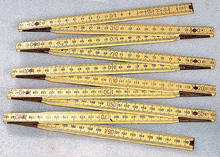Zigzag

A zigzag is a pattern made up of small corners at variable angles, though constant within the zigzag, tracing a path between two parallel lines; it can be described as both jagged and fairly regular.
From the point of view of symmetry, a regular zigzag can be generated from a simple motif like a line segment by repeated application of a glide reflection.
The origin of the word is unclear. Its first printed appearance was in French books in the late 17th century.[1]
Examples of zigzags

Lightning and other electrical hazards are often depicted with a zigzag design, with long downward strokes and short backward ones.
The trace of a triangle wave or a sawtooth wave is a zigzag.
Pinking shears are designed to cut cloth or paper with a zigzag edge, to lessen fraying.
A carpenter's folding ruler can be folded to look like a zigzag.
Zigzags are a basic decorative pattern used on pottery, and are often seen in the cuts which separate pieces of ravioli pasta.
In sewing, a zigzag stitch is a machine stitch in a zigzag pattern.
The zigzag arch is an architectural embellishment used in Islamic, Byzantine, Norman and Romanesque architecture.[2][3]
See also
References
- ↑ Google Books: "Word Origins and how we know them"
- ↑ Allen, Terry (1986). "4". A Classical Revival in Islamic Architecture. Wiesbaden.
- ↑ Allen, Terry (2008). Pisa and the Dome of the Rock (electronic publication) (2nd ed.). Occidental, California: Solipsist Press. ISBN 0-944940-08-0. Retrieved January 28, 2012.
Bibliography
- Wedgwood, Hensleigh (1855). "On Roots mutually connected by reference to the term Zig-zag". Transactions of the Philological Society (2).
| Wikimedia Commons has media related to Zigzag. |